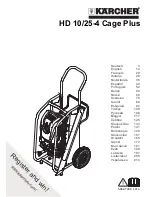
4
2 IMPORTANT PRECAUTIONS
• Read and understand all the instructions before use.
• The user is responsible for any accident resulting from not following this manual.
• Keep the pressure cooker, when in use, away from children or pets.
• Never leave the pressure cooker unattended. Supervision is needed during use, for adjusting the power level when the
pressure-limiting valve (fig1.7) is releasing steam, and for keeping the pressure under the limited pressure during the
cooking process.
• Never put the pressure cooker in a heated oven/microwave.
• Never carry the pressure cooker with the foldable handle (fig1.2)
• Pay attention to the moving parts (clamps) of the locking system (fig1.5)
• The pressure cooker should always be used on a steady cooking surface.
• Don’t put the pressure cooker on a coil with a bigger diameter than the cooker’s bottom. When cooking on gas, the flames
shall not reach the cooker’s wall.
• Only use this pressure cooker on heat sources mentioned in this manual (see the icons in section 1)
• When moving or carrying the pressure cooker, while under pressure, remember to move with greatest care. Move it
horizontally and put it down gently. Don’t bump. Do not touch hot surfaces, use the lower body handles (fig1.11). Never
carry the cooker using the foldable handle (fig1.2). If necessary, use gloves or other protecting materials.
• Do not use the pressure cooker for other than intended use.
• This appliance cooks under pressure and therefore can cause scalds (in case of improper use). Make sure that the cooker
is properly closed before use. Please refer to the chapter “Instructions for use” and pay attention to the moving clamps of
the locking system. (fig1.5)
• Never open the pressure cooker with force. Do not open before its internal pressure has completely dropped. Please refer
to the chapter “Getting started and how to cook”.
• Never use your pressure cooker without adding water or liquid; this would seriously damage it. Avoid total evaporation and
don’t heat dry.
• Don’t cook expansive food such as apple jam, pearl rice, seaweed, oatmeal, etc. to avoid blocking of the steam-releasing
hole. Do not fill the pressure cooker beyond 2/3 of its capacity. (see marking inside the cooker) (fig. 3)
• When cooking foods that expand during cooking, such as rice or dehydrated vegetables, don’t fill it beyond 1/4 of its
capacity.
• Allowed volume of food inside the pressure cooker:
• Less than 1/4 of the cooker height for expansive food such as rice, beans, etc. (fig.2)
• Less than 2/3 of the cooker height for non-expansive food such as meat, vegetables, etc. (fig.3).
• After cooking meat with a skin (e.g. beef tongue or chicken) which may swell under the effect of pressure and after the
pressure cooker has cooled down to open, make sure that you do not puncture the meat while the skin is swollen to avoid
scalds
• When cooking doughy food (that tends to foam) and after the pressure cooker has cooled down to open, gently shake the
pressure cooker before opening, to avoid food ejection and scalds.
• Before each use, make sure that the valves are not obstructed. In general, keep the pressure-limiting valve (fig1.7), safely
open-preventing valve (fig1.8), sealing ring (fig1.9), knob (fig1.1), lid and body (fig1.10) clean and out of dirt before and
after using. Please refer to the chapter “Getting started and how to cook”.
• It’s prohibited to put anything on the pressure-limiting valve (fig1.7 + fig.4).
• Never use the pressure cooker for pressure deep-frying oil or shortening. Don’t use for frying or baking food.
• Don’t point the opening of the safely open-preventing valve (fig 1.8) towards your body.
• If steam sprays out from the safely open-preventing valve (fig1.8) or the sealing ring (fig1.9) squeezes out from the
safety window (fig1.6), the power shall be shut off immediately. The problem should be found and solved before using the
pressure cooker.


































